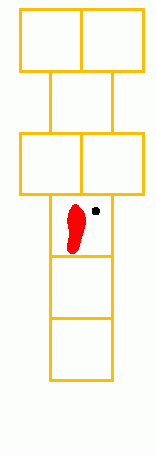Hopscotch
Hopscotch is a popular children's game that can be played with several players or alone. Hopscotch involves drawing a series of numbered boxes on the ground, which players then hop through, skipping boxes according to various rules. The game is known for its simplicity and can be played on any hard surface with nothing more than a piece of chalk and a small object such as a stone, beanbag, or shell. The object is tossed into a numbered square, and the player then hops through the squares on one foot to retrieve the object. The game is not only a fun activity but also helps in developing physical coordination, balance, and agility among children.
History[edit | edit source]
The origins of Hopscotch are believed to date back to the Roman Empire. It was initially a military training exercise for Roman soldiers, which later evolved into a children's game. The English name "Hopscotch" is derived from "hop" meaning to jump, and "scotch" meaning to score or scratch, referring to the lines drawn for the game. Over the centuries, Hopscotch has spread across the globe, with variations of the game being found in many countries, each with its unique rules and configurations.
Gameplay[edit | edit source]
The basic form of Hopscotch involves drawing a series of linear or spiral boxes on the ground. The traditional European and North American version has a linear pattern, usually with eight or ten numbered boxes. The player throws a small object, often called a "puck" or "pebble," into the first box. The player then hops through the grid, skipping the box containing the object. Single boxes must be hopped on one foot, while side-by-side boxes can be landed on with two feet. The player continues the sequence, throwing the object into the next box. If the player successfully completes the course, they continue their turn by throwing the object into the next box. The game continues until the player fails to complete a sequence, such as stepping on a line, missing a box with the object, or losing balance.
Variations[edit | edit source]
There are many variations of Hopscotch played around the world. For example, in some Asian countries, the game includes a spiral pattern, often referred to as "Snake Hopscotch" or "Escargot." Each country and culture has its unique twist on the game, with different rules, patterns, and names.
Educational Value[edit | edit source]
Hopscotch is not only a recreational activity but also has educational value. It promotes physical fitness, coordination, and balance. The game also encourages social interaction, turn-taking, and rule-following among children. Furthermore, it can be used as a tool for teaching numbers and spatial awareness.
In Popular Culture[edit | edit source]
Hopscotch has been referenced in various forms of popular culture, including literature, film, and music. It often symbolizes childhood innocence and nostalgia. The game's simplicity and universal appeal have made it a timeless classic, transcending generations and cultures.
Search WikiMD
Ad.Tired of being Overweight? Try W8MD's physician weight loss program.
Semaglutide (Ozempic / Wegovy and Tirzepatide (Mounjaro / Zepbound) available.
Advertise on WikiMD
|
WikiMD's Wellness Encyclopedia |
| Let Food Be Thy Medicine Medicine Thy Food - Hippocrates |
Translate this page: - East Asian
中文,
日本,
한국어,
South Asian
हिन्दी,
தமிழ்,
తెలుగు,
Urdu,
ಕನ್ನಡ,
Southeast Asian
Indonesian,
Vietnamese,
Thai,
မြန်မာဘာသာ,
বাংলা
European
español,
Deutsch,
français,
Greek,
português do Brasil,
polski,
română,
русский,
Nederlands,
norsk,
svenska,
suomi,
Italian
Middle Eastern & African
عربى,
Turkish,
Persian,
Hebrew,
Afrikaans,
isiZulu,
Kiswahili,
Other
Bulgarian,
Hungarian,
Czech,
Swedish,
മലയാളം,
मराठी,
ਪੰਜਾਬੀ,
ગુજરાતી,
Portuguese,
Ukrainian
Medical Disclaimer: WikiMD is not a substitute for professional medical advice. The information on WikiMD is provided as an information resource only, may be incorrect, outdated or misleading, and is not to be used or relied on for any diagnostic or treatment purposes. Please consult your health care provider before making any healthcare decisions or for guidance about a specific medical condition. WikiMD expressly disclaims responsibility, and shall have no liability, for any damages, loss, injury, or liability whatsoever suffered as a result of your reliance on the information contained in this site. By visiting this site you agree to the foregoing terms and conditions, which may from time to time be changed or supplemented by WikiMD. If you do not agree to the foregoing terms and conditions, you should not enter or use this site. See full disclaimer.
Credits:Most images are courtesy of Wikimedia commons, and templates, categories Wikipedia, licensed under CC BY SA or similar.
Contributors: Prab R. Tumpati, MD





